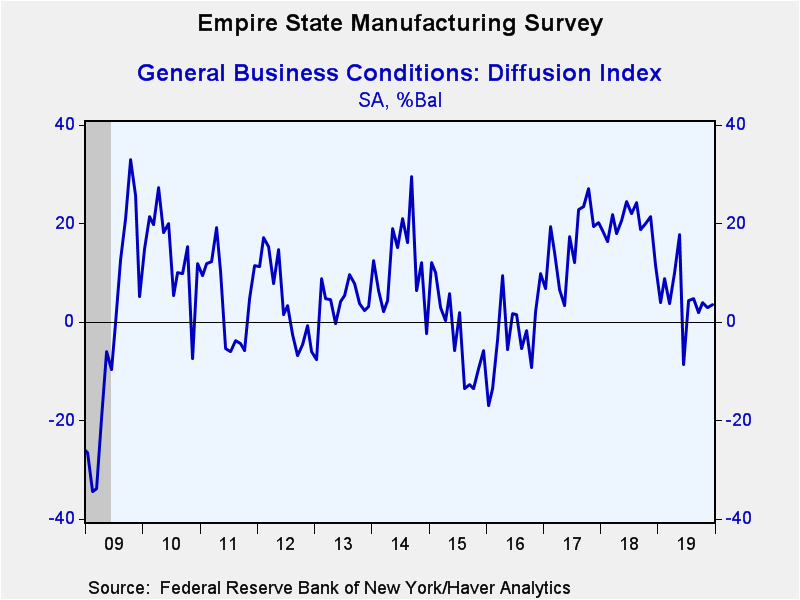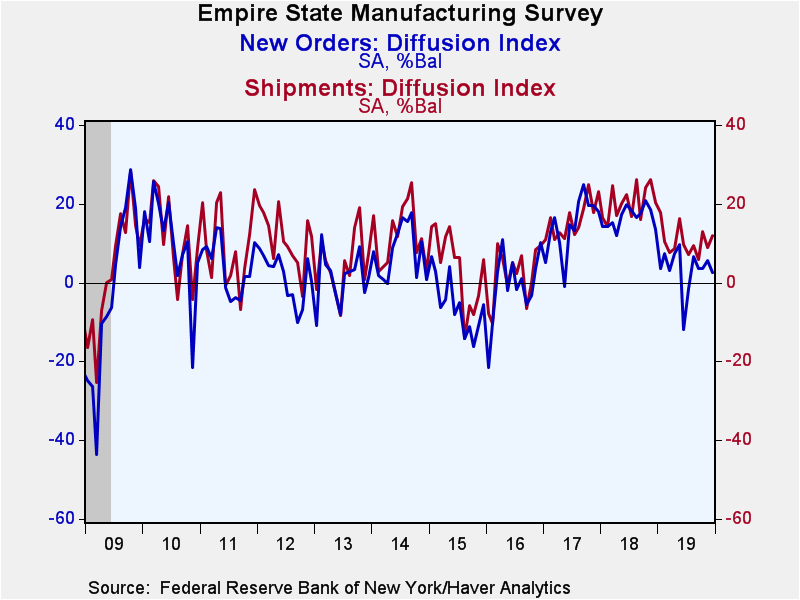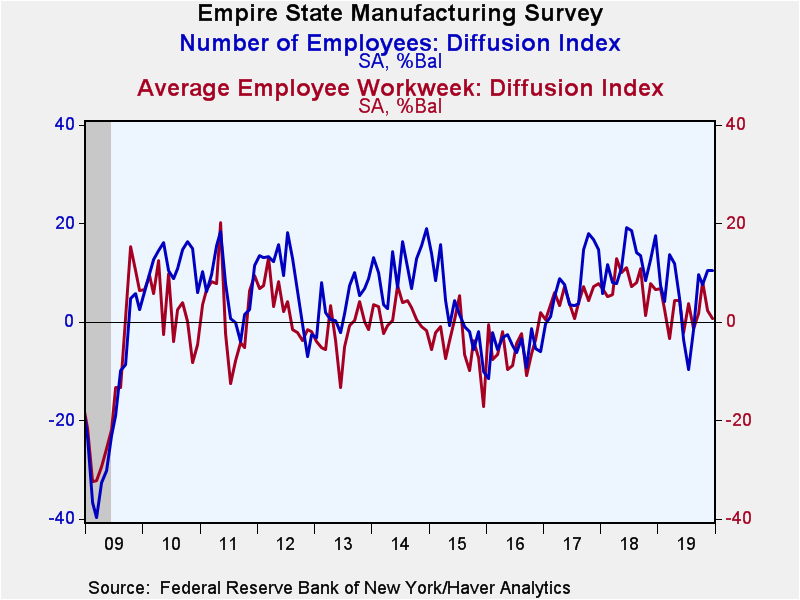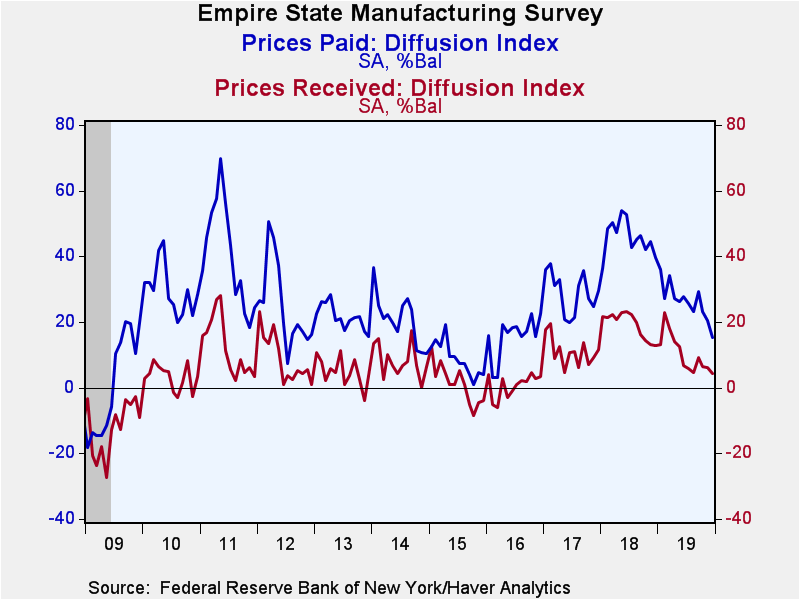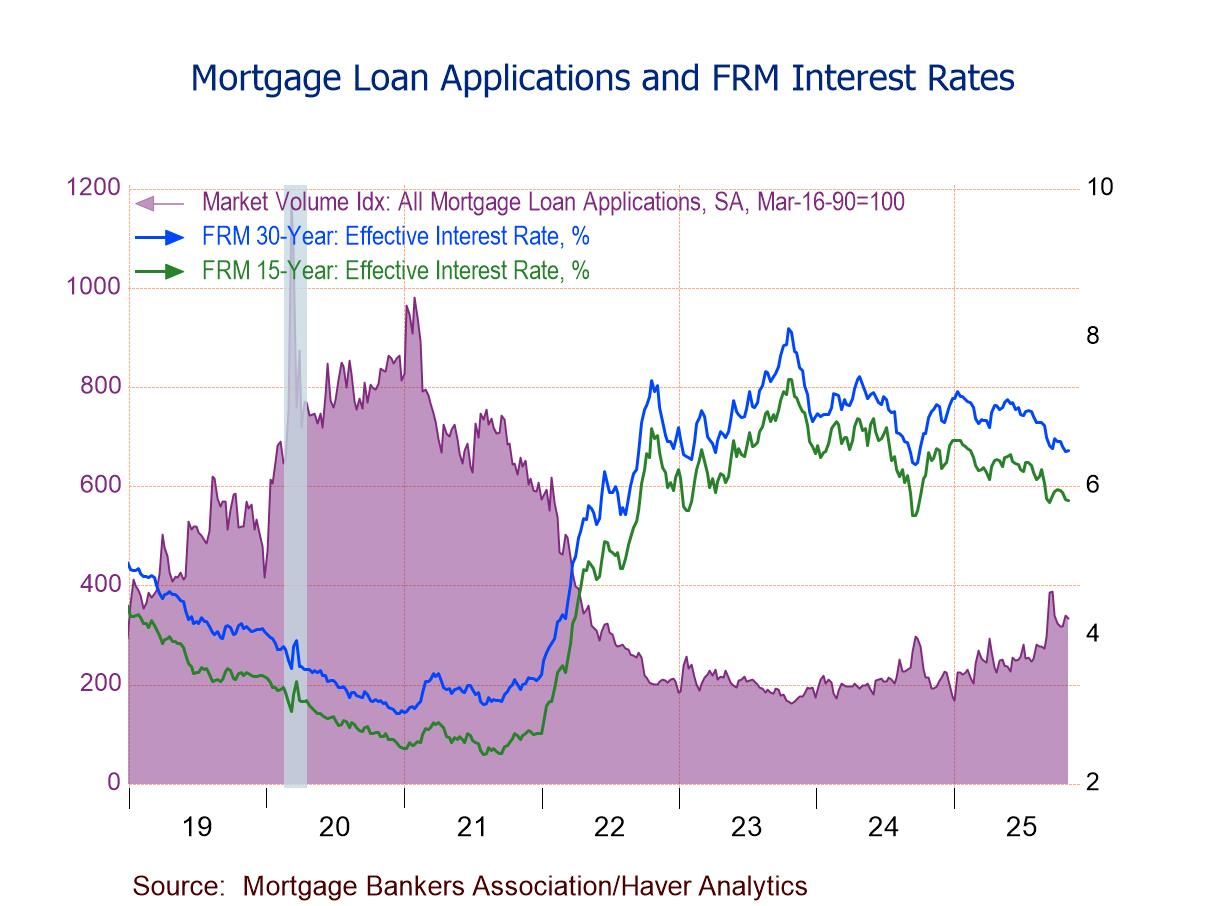 Global| Dec 16 2019
Global| Dec 16 2019Empire State Manufacturing Activity Slowed in November
by:Tom Moeller
|in:Economy in Brief
Summary
The Empire State Manufacturing Index of General Business Conditions edged down to 2.9 in November from 4.0 in October. An increase to 5.0 had been expected by the Action Economics Forecast Survey. This means that activity continued to [...]
The Empire State Manufacturing Index of General Business Conditions edged down to 2.9 in November from 4.0 in October. An increase to 5.0 had been expected by the Action Economics Forecast Survey. This means that activity continued to increase but at a slower pace than in October. Twenty-eight percent of respondents reported that conditions had improved in November from October while 25.5% reported a worsening. The Empire State data, reported by the Federal Reserve Bank of New York, reflect business conditions in New York state, northern New Jersey and southern Connecticut.
The headline index reflects answers to a separate question. In contrast, the ISM indexes are constructed from the component indexes. Haver Analytics calculates a seasonally adjusted index that is comparable to the headline ISM index from the components of the Empire State index. The ISM-adjusted index eased further to 51.3 in November from 52.1 in October and 52.8 in September but remained in expansion territory and well above the recent low of 48.4 in June. A reading of 50 or greater indicates expansion in business activity. During the past 15 years, there has been a 64% correlation between the index level (which measures change) and the quarter-to-quarter percent change in real GDP.
The component series in the Empire State survey continued to demonstrate a mixed performance. The new orders index picked up while the shipments index slowed. Unfilled orders remained negative but less so than in October. Delivery times shortened while inventories were modestly lower.
Labor market conditions in November were solid. Employment continued to expand and at a faster pace than in October. The average workweek also lengthened in November but by less than in October. Twenty-two percent of respondents reported increased jobs while 11.6% report fewer jobs.
The prices paid index slowed to 20.5 in November from 23.1, indicating that the pace of input price increases slowed. The prices received index was little changed at 6.2 in November (6.3 in October).
The series measuring expectations for business conditions in six months rose for the second consecutive month to 19.4 in November from 17.1 in October. The capital expenditures index jumped 10 points to 19.2 while the technology spending index rose markedly to 15.1 from 8.8.
The Empire State figures are diffusion indexes, which are calculated by subtracting the percentage of respondents reporting declines from the percentage reporting gains. Their values range from -100 to +100. The data are available in Haver's SURVEYS database. The ISM-adjusted headline index dates back to 2001. The Action Economics Forecasts can be found in Haver's AS1REPNA database.
| Empire State Manufacturing Survey | Dec | Nov | Oct | Dec'18 | 2019 | 2018 | 2017 |
|---|---|---|---|---|---|---|---|
| General Business Conditions (Diffusion Index, %, SA) | 2.9 | 4.0 | 21.4 | 19.8 | 16.1 | ||
| General Business Conditions Index (ISM Adjusted, >50=Increasing Activity, SA) | 51.3 | 52.1 | 57.3 | 56.4 | 54.6 | ||
| New Orders | 5.5 | 3.5 | 18.6 | 16.5 | 14.5 | ||
| Shipments | 8.8 | 13.0 | 26.1 | 20.4 | 15.9 | ||
| Unfilled Orders | -8.2 | -12.5 | 0.0 | 3.5 | 1.9 | ||
| Delivery Time | -5.5 | -2.5 | 4.4 | 9.1 | 6.1 | ||
| Inventories | -6.2 | -0.6 | 10.9 | 5.9 | 1.5 | ||
| Number of Employees | 10.4 | 7.6 | 12.7 | 12.4 | 8.1 | ||
| Average Employee Workweek | 2.3 | 8.3 | 7.9 | 7.8 | 4.6 | ||
| Prices Paid | 20.5 | 23.1 | 44.5 | 45.8 | 29.0 | ||
| Prices Received | 6.2 | 6.3 | 13.1 | 19.3 | 11.0 | ||
| Expectations 6 Months Ahead | 19.4 | 17.1 | 32.9 | 35.2 | 42.7 |
Tom Moeller
AuthorMore in Author Profile »Prior to joining Haver Analytics in 2000, Mr. Moeller worked as the Economist at Chancellor Capital Management from 1985 to 1999. There, he developed comprehensive economic forecasts and interpreted economic data for equity and fixed income portfolio managers. Also at Chancellor, Mr. Moeller worked as an equity analyst and was responsible for researching and rating companies in the economically sensitive automobile and housing industries for investment in Chancellor’s equity portfolio. Prior to joining Chancellor, Mr. Moeller was an Economist at Citibank from 1979 to 1984. He also analyzed pricing behavior in the metals industry for the Council on Wage and Price Stability in Washington, D.C. In 1999, Mr. Moeller received the award for most accurate forecast from the Forecasters' Club of New York. From 1990 to 1992 he was President of the New York Association for Business Economists. Mr. Moeller earned an M.B.A. in Finance from Fordham University, where he graduated in 1987. He holds a Bachelor of Arts in Economics from George Washington University.


